Rhamnus alaternus
L. Italian BuckthornShrub 1.5–3 m high; young shoots shortly simple-pubescent. Leaves alternate (rarely subopposite), ovate, elliptic or obovate, 20–70 mm long, 12–35 mm wide, acute to obtuse, margins regularly toothed to irregularly toothed only in upper half; stipules subulate, 1–1.5 mm long. Inflorescence of axillary (and sometimes terminal) racemes, often branched, 1–2.5 cm long, axis thickish, minutely yellow-pubescent; bracts triangular, c. 1 mm long, finally deciduous. Flowers yellow-green, glabrous, male and/or bisexual within the same inflorescence; pedicels subequal to bracts; hypanthium conical, c. 2 mm long; sepals spreading to recurved, c. 1.5 mm long; petals absent; stamens erect, subequal to sepals; ovary glabrous, style not or barely exceeding hypanthium. Drupes obovoid to globular, c. 5 mm long, initially red, ripening black. Flowers May–Oct.
MuM, GleP, Brid, VVP, GipP, OtP, WaP, Gold, DunT, HSF. Also naturalised WA, SA, Qld, NSW, Tas. Native to coasts of the Mediterranean. Invasive in coastal scrub near Portland, Port Fairy, Torquay, and Bellarine and Mornington Peninsulas. Grows on (particularly calcareous) sands of dunes and coastal flats, with inland occurrences at Castlemaine and at Wannon Falls near Hamilton.
Walsh, N.G. (1999). Rhamnus. In: Walsh, N.G.; Entwisle, T.J., Flora of Victoria Vol. 4, Cornaceae to Asteraceae, pp. 84–85. Inkata Press, Melbourne.
 Spinning
Spinning




